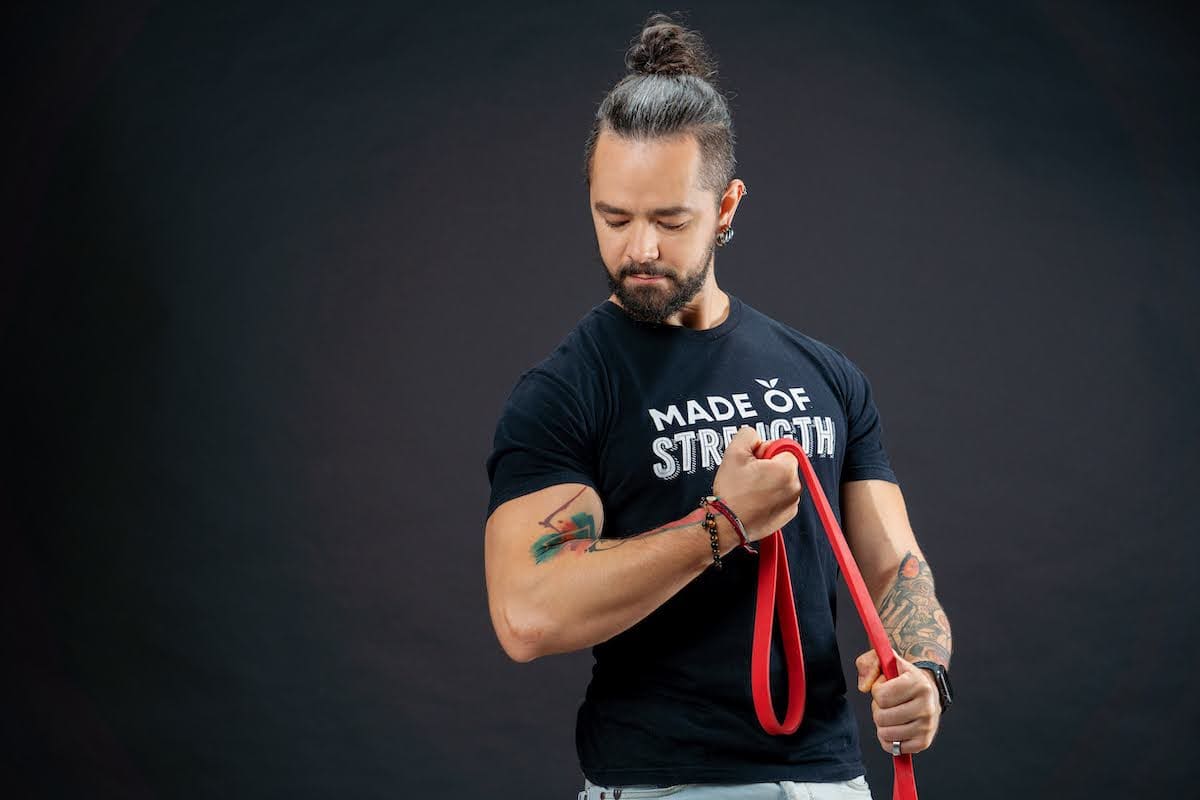Muscle tension and tightness strike all of us at one time or another. After any great workout, you need to rest to recover. From breathing exercises to hot compresses, many methods exist to relax muscles.
However, with the hustling and bustling of life, relaxation isn’t always at the top of our priorities. So what is the most efficient way to recover in no time?
Let’s dive in.
What’s the difference between muscle tightness and muscle tension?
Quite often, muscle tightness and muscle tension are used interchangeably. So, we understand how there can be confusion between the two.
Muscle tightness (also known as muscle stiffness) is when your muscles feel tight and even after rest, you find it more difficult to move than normal. Your muscles may feel dull, tight, and achy while you’re resting, or tired, heavy, and burning while exercising.
Thankfully, muscle tightness usually goes away on its own. You can do stretches or exercises to relieve the feeling of discomfort.
Muscle tension (also known as muscle rigidity), on the other hand, is when your muscles aren’t able to relax normally. Your brain continues to send signals to a muscle or a group of muscles to contract even though there’s no longer a need for movement. So, these muscles stay contracted or partly contracted for a period of time, causing you to feel aches or sharp pain at rest or when you’re exercising. It’s one of the most common causes of muscle pain.
With muscle tension, recovery includes ice, rest, and more movement to encourage blood circulation. (Blood circulation brings nutrients to the injured area and helps with recovery.) But if it’s a significant injury, it’s advisable to consult with a medical professional.
What causes muscle tightness and tension?
Any time you stress your muscles during a workout, you create microscopic tears in the muscle fibers, which causes muscle tightness or tension. But if you allow your muscles to relax and recover, they will heal stronger than they were before.
Recovery time doesn’t mean vegging on the couch. It means slow, gentle movement to keep the blood circulating in the muscles. It also means deep rest: the kind you get only during sleep or meditation.
The effects of stress on your muscles
Oh, the damage stress causes to your body. It’s so detrimental that we basically want to say, “Dear stress, let’s break up.”
While muscle tightness occurs when you put stress on your body, like exercise, muscle tension can be triggered by internal and external stress.
If you don’t find a way to release that tension, it can create serious muscle imbalances. This is especially so if the muscle tension is in your upper back and neck (and general stiffness from unconsciously tensing your body).
But that’s just talking about physical stress. Now, let’s get to emotional stress. This type of stress is the worst culprit in chronic muscle tension. When you’re emotional, parts of your body tend to tense up, like your jaw from clenching or your diaphragm from rapid breathing.
Another one to mention is environmental stress. An example of this type of stress is artificial ingredients from processed foods. It can impede proper muscle functioning, which can compound the problem of sore muscles.
Could you be tensing your muscles unconsciously?
If you find that you suffer from chronic muscle tension, it’s likely that you’re unconsciously tensing your muscles in response to ongoing stress. The muscle spasms are most likely constricting your blood vessels and contributing to the discomfort you’re feeling.
The fix? Practice deciphering the difference between a tense muscle and a muscle at rest. Systematically tense different muscle groups. Start with your feet, and slowly work your way up to your body, neck, shoulders, and head.

How do you relax your muscles?
Now that you have a better idea of what contributes to tight and tense muscles, let’s explore ways to relax your muscles. There are several methods you can use, from breathing exercises to stretching to massage. So, pick one (or all) that works best for you and your body.
Check out these 11 suggested ways to loosen muscles:
1. Meditation
Meditation is the number one way to relieve stress and relax muscles.
You can meditate just before you go to bed to ensure that your body is completely relaxed before you hit the hay or first thing in the morning to approach the day with a positive attitude that will help prevent stress in the first place.
This is the one relaxation technique that is best done every day.
And it doesn’t take long! Just 15-30 minutes will have you so relaxed that the world has melted away… at least while you’re meditating.
All you need is a pair of headphones and an MP3 player. Then sit comfortably, close your eyes and Omharmonics’ binaural beats will create a meditative state in your brain very quickly.
That’s all you have to do. You can get into the soundtrack, repeat mantras, focus on becoming more relaxed, or simply do nothing at all.
2. Stretching
Muscles that won’t relax will take longer to recover if you don’t address it quickly. And stretching is essential after a workout.
Even if you’ve done nothing but sit all day, a stretch will feel amazing! Get the kinks out by stretching every day.
Sometimes, the best stretches are counter-intuitive: if you have pain in a particular muscle, you may need to contract it and stretch the opposing muscle. This is especially effective for back pain or tension.
The yoga pose, “cobra” is a great one to relieve back tension. But please learn how to do the cobra so you don’t hurt yourself.
Never push a stretch to the point of pain, and never bounce. Just relax into it, breathing into the stretch until you feel a release in the muscle (a minute or two) and then going deeper. Stop when it hurts. Stretching should feel good.
Stretching helps release toxins built up in the muscles and improves your range of motion. For even more toxin-flushing, treat yourself to a massage and drink plenty of water afterward.
3. Breathing
Often, your breathing is shallow and rapid when you’re stressed, causing your muscles to not relax.
You can practice breathing deeply to relax your muscles fast. Simply focus on a long, steady exhale. Exhale for 10-20 breaths and feel the tension and tightness dissipate from your muscles. (Don’t worry about the inhale—your body will take care of that.)
Do this deep breathing when you’re stretching, too, for an even deeper stretch. As you exhale, visualize all tightness and tension leaving the muscle that is being stretched.
Deep breathing comes naturally as part of meditation practice, but you can use deep breathing anytime to relax your muscles.
4. Warm-up
Saunas, hot baths, hot showers, hot tubs, and steam rooms increase circulation and encourage relaxation, both physically and mentally.
You can stretch, too, while enjoying deep, penetrating heat.
One commonly overlooked relaxation technique is to drink plenty of water after any kind of hot therapy, to replenish water lost due to sweating.
5. Drink water
Staying hydrated will help relax muscles too, by keeping the cells supple and by helping flush out toxins.
Avoid sugary or artificially sweetened energy drinks or sodas, though. If you need to replace electrolytes and minerals after a workout, supplement with a beverage like coconut water.
6. Rest
One of the best ways to relax your muscles is to rest.
Look into R.I.C.E—Rest, Ice, Compress, Elevation—especially if your injury is on the more extreme side.
But avoid vegging on the couch for more than a day. Along with good sleep and meditation, movement is also helpful with recovery, believe it or not. Do some moving workouts, like a gentle stroll, a leisurely swim, or hatha yoga.
7. Do yoga
Yoga is known to help with muscle flexibility and improve your range of motion. This not only helps bigger muscle areas, like your back but also smaller muscle areas like your neck.
And speaking of yoga, if you practice one of the more aerobic or intense yoga styles, do a more stretch or relaxation-oriented class at least twice a month to give your muscles a break from rigorous exercise and incorporate more gentle stretching.
8. Get a massage
Certified massage therapists can work your muscles to relieve discomfort in muscle fibers that won’t relax with regular stretching. Here are a few great massages to experience for sore muscles:
- Hot stone massage combines massage with warmth, allowing the heat from the stones to penetrate into the deeper muscles of your body.
- Aromatherapy massage encourages relaxation. Bonus: the essential oils also have additional benefits that will help with recovery.
- Deep tissue massage or sports massage is essentially a Swedish Massage, but with firm pressure. It helps loosen the muscle tissues and encourages blood circulation.
During the massage, focus on deep breathing. Be sure to drink lots of water afterward to help flush the toxins that were released from your muscles.
9. Use acupuncture or acupressure
Acupuncture and acupressure essentially follow the same concept: specific points on the body are stimulated to release energy blocks that are causing the body pain.
The main difference between the two is that acupuncture uses needles and acupressure specialized tools or simply the fingers.
There are many pressure points that lie along the body’s meridians, each corresponding to a certain muscle or muscle group. A trained acupuncturist can help relax a tense muscle quickly and painlessly, relieving you of discomfort and pain.
10. Drink green tea
Drink antioxidant-rich green tea to help reduce damage to muscle tissue and speed healing. A healthy, supple muscle is a happy muscle.
11. Take a mineral supplement rich in magnesium
This essential mineral aids in relaxation, nerve signaling, and muscle contraction. Eat spinach, almonds, and other nuts, squash, and fish to ensure you’re getting enough magnesium.
A tensed muscle becomes a stiff muscle, so a proper stretch is essential after a workout. Even if you’ve done nothing but sit all day, a stretch will feel amazing!
Get the kinks out by stretching every day.









